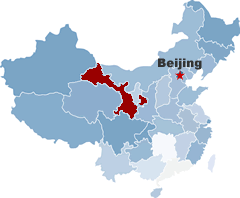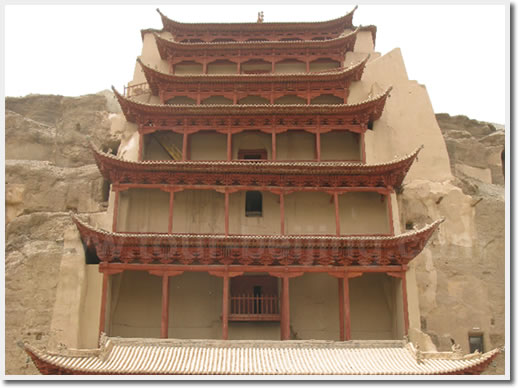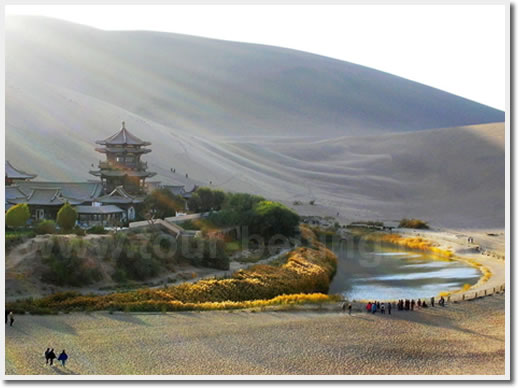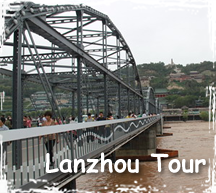Gansu Travel Guide
 Location: Gansu is situated in the up section of Yellow River, the northwest of China.
Location: Gansu is situated in the up section of Yellow River, the northwest of China.
Population: 25,575,254
Area: with an area of 453,700 square kilometers
Nationalities: Han, Dongxiang, Yugu, Baoan, Hui, Tibet, etc.
History: The history of Gansu could be traced back to Xia Dynasty, Gansu was under administration of Yongzhou. The Qin State formed from the Tianshui area of Gansu. The ancestors of Zhou (11-256 B.C.) and Qin (221-206 B.C.), both took the eastern part of Gansu as their base. During the period of the Han Dynasty, Emperor Wu set up four Juns, Wuwei, Zhanfye, Jiuquan and Dunhuang in Hexi, after that a succession of other Juns were established such as Tianshui Jun, Anding Jun, Wudu Jun and Jinzheng Jun.
In the periods of the Sui and Tang dynasties, The administrative areas were divided according to state, prefecture and county. In the period of the Three Kingdoms the majority of the Gansu Province belonged to Wei. Up to the Tang Dynasty, it was under the administration of Guanlei and Longyou Dao. As for the Song Dynasty, there were 17 states under the jurisdiction of Yongxing, Qinfeng and Lizhou Lu.
In the Yuan Dynasty, the system of provinces was adopted and China was divided into 11 provinces. In the Ming Dynasty, the province system was abolished and 13 Chengxuan Buzhengshishi were set up and most of present day Gansu was governed by Shanxi Buzhengshishi. In 1928, Qinghai and Ningxia set up provinces respectively, the territory of Gansu became much less and Gansu was divided into one city ( Lanzhou ), 69 counties and 2 bureaus.
Climate: The climate of Gansu is temperate monsoonal but it has the typical characteristics of the continental climate. The annual average temperature is between 0 to 14 degrees Celsius dropping from the southeast to the northwest. The hottest month is July with an average temperature of 20℃-24℃ and January is the coldest month reaching an average temperature of -12℃-2℃. The annual average rainfall is 50-800mm approximately.
Transportation: Air- There are 10 airports forming an airline net to Beijing, Tianjin, Shanghai, Hangzhou as well as other big cities.
Railway-Longhai Line, Lanxin Line, Baolan Line, Lanqing Line, Ganwu Line, Baozhong Line.
Highway-Tianding Expressway, Tianbao Expressway, Pingding Expressway, Xilan Road, Ganxin Road, Ganchuan Road, Jingzang Road.
Specialties: Cucurbit Carving, Yellow River Stone Carving, Flower Vase, Wool Fabric
Local Food: The food in Gansu is quite unique compared to that of central China, having been influenced by ethnic groups - especially the Hui people. Besides the beef noodles, there are local delicacies that cannot be tasted in other places, as well as Sichuan cuisines, hotpot, and western food.
Attractions: Dunhuang Mogao Cave-The Mogao Grottoes is one of three noted grottoes in China and also the largest, best preserved and richest treasure house of Buddhist art in the world. 492 caves still stand, containing some 2,100 colored statues and 45,000 square meters of murals.

Crescent Lake-the Crescent Lake is in a natural shape of half-moon and had been commonly considered as one of the Eight Great Landscapes of Dunhuang together with the Echoing-Sand Mountain early in Western Han Dynasty (206BC-24AD).

Jiayuguan Pass-Jiayuguan Pass is the main part of the western end of the Great Wall built in the Ming Dynasty. It has been the first pass of Hexi region since ancient times. Jiayuguan Pass has the overlapped structure consisting of three layers of defense (inner city, outer city and moat). It was connected with the Great Wall to constitute a military defensive system of “One flint every five li; one frusta every ten li; one fortress every thirty li; and one city every one hundred li.”
Questions & Answers:



